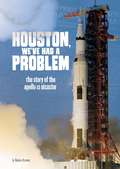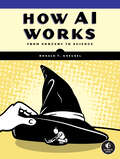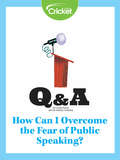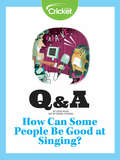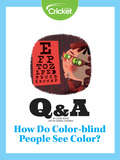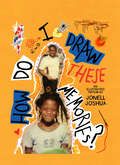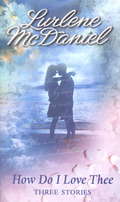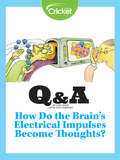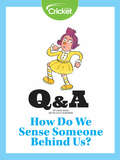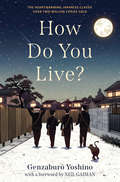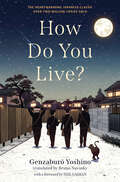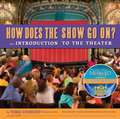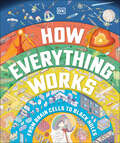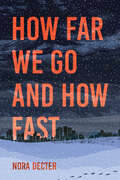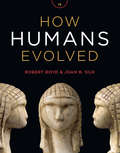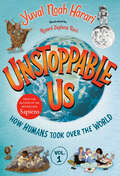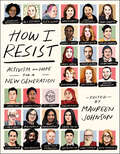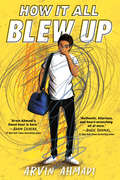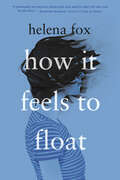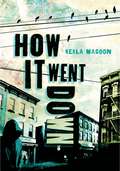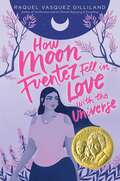- Table View
- List View
Houston, We've Had a Problem: The Story of the Apollo 13 Disaster (Tangled History)
by Rebecca RissmanIn an immersive, exciting narrative nonfiction format, this powerful book follows a selection of people who experienced the events surrounding the Apollo 13 disaster.
How AI Works: From Sorcery to Science
by Ronald T. KneuselAI isn&’t magic. How AI Works demystifies the explosion of artificial intelligence by explaining—without a single mathematical equation—what happened, when it happened, why it happened, how it happened, and what AI is actually doing "under the hood."Artificial intelligence is everywhere—from self-driving cars, to image generation from text, to the unexpected power of language systems like ChatGPT—yet few people seem to know how it all really works. How AI Works unravels the mysteries of artificial intelligence, without the complex math and unnecessary jargon.You&’ll learn: The relationship between artificial intelligence, machine learning, and deep learningThe history behind AI and why the artificial intelligence revolution is happening nowHow decades of work in symbolic AI failed and opened the door for the emergence of neural networksWhat neural networks are, how they are trained, and why all the wonder of modern AI boils down to a simple, repeated unit that knows how to multiply input numbers to produce an output number.The implications of large language models, like ChatGPT and Bard, on our society—nothing will be the same againAI isn&’t magic. If you&’ve ever wondered how it works, what it can do, or why there&’s so much hype, How AI Works will teach you everything you want to know.
How America Works: Understanding Your Government And How You Can Get Involved
by Elliott RebhunLearning about civics shouldn't be boring. How America Works gives teens a fun, behind-the-scenes look at how the U.S. government works, why they should care and how they can get involved. But this isn’t just any old civics primer. Appealing graphics and a conversational tone draw readers in from the very first page. Political cartoons and debates spark critical thought. And age-appropriate explanations make even the most complex civics topics accessible and easy to understand. In short, this comprehensive guide has everything teens need to know about government and civic engagement (and probably don’t).
How Can I Overcome the Fear of Public Speaking?
by Lizzie WadeSome people are afraid of public speaking more than others. Learn about some surprising ways to overcome stage fright.
How Can Some People Be Good at Singing?
by Lizzie WadeSome people are better at singing than others. Why is that? A researcher explains why some people love doing karaoke, and others simply can't do it.
How Do Color-blind People See Color?
by Lizzie WadeTo understand what it means to be color-blind, you must first understand how most of us see color.
How Do I Draw These Memories?: An Illustrated Memoir
by Jonell JoshuaJonell Joshua spent her childhood shuttling back and forth between Savannah and New Jersey – living in grandparents’ homes during the times her mother, struggling with mental illness, needed support to raise her and her brothers. Together the family found a way to keep going even in the darkest of times. How Do I Draw These Memories? is an illustrated memoir about nostalgia, faith, the preciousness of life, and unconditional love. From Jonell’s devastatingly brilliant pen as a writer and an artist, it plumbs the depths of what family can be – and how joy and hope can be found in the most ordinary and extraordinary moments. P R A I S E "Ingenious… a vulnerable, revealing homage to family." —Booklist "Despite the difficulties confronting Jonell’s family, this memoir is uplifting and amazingly positive, in some ways celebrating the ordinariness of life as well as the power of unconditional love (which I hope) most experience. Readers are likely to recognize something of their own lives in this memoir." —Reading Rockets
How Do I Love Thee
by Lurlene McdanielThough written more than a century ago, Elizabeth Barrett Browning's beautiful sonnet rings true today for three young couples who believe in the power of love. <P> In "Night Vision," Brett finds a way to brighten a special girl's lonely existence.<P> "Bobby's Girl" features Dana, who must choose between two brothers, both of whom she loves.<P> "Laura's Heart," the third story, introduces 16-year-old Laura Carson, who is hospitalized on a regular basis because of her weak heart. But when tragedy strikes a loved one, she realizes her heart is stronger than she thought and that love lives on forever.
How Do the Brain's Electrical Impulses Become Thoughts?
by Lizzie WadeHow do brain impulses translate into a state of mind? This Q & A explores the science of the brain and gives an insight into feelings and abilities.
How Do We Sense Someone Behind Us?
by Lizzie WadeHow do humans sense when someone is behind them? This Q & A explains the science of peripheral vision.
How Do You Live?
by Genzaburo YoshinoAnime master Hayao Miyazaki's favorite childhood book and a beloved Japanese classic, this uplifting coming-of-age story brings philosophy, history and wonder together, available in English for the first time.The streets of Tokyo swarm below fifteen-year-old Copper as he gazes out into the city of his childhood. Struck by the thought of the infinite people whose lives play out alongside his own, he begins to wonder, how do you live? Considering life's biggest questions for the first time after the death of his father, Copper turns to his dear uncle for heart-warming wisdom. As the old man guides the boy on a journey of philosophical discovery, a timeless tale unfolds, offering a poignant reflection on what it means to be human. But when Copper betrays one of his new friends, how will he ask for forgiveness — and how can he forgive himself? How Do You Live? is the inspiring, transformative story of a young man who, like his namesake Copernicus, looks to the stars and uses his discoveries to answer the question of what kind of person he will grow up to be.
How Do You Live?
by Genzaburo YoshinoThe first English translation of the classic Japanese novel, a childhood favorite of anime master Hayao Miyazaki (Spirited Away, My Neighbor Totoro, Howl’s Moving Castle), with an introduction by Neil Gaiman. <p><p> First published in 1937, Genzaburō Yoshino’s How Do You Live? has long been acknowledged in Japan as a crossover classic for young readers. Academy Award–winning animator Hayao Miyazaki has called it his favorite childhood book and announced plans to emerge from retirement to make it the basis of a final film. <p><p> How Do You Live? is narrated in two voices. The first belongs to Copper, fifteen, who after the death of his father must confront inevitable and enormous change, including his own betrayal of his best friend. In between episodes of Copper’s emerging story, his uncle writes to him in a journal, sharing knowledge and offering advice on life’s big questions as Copper begins to encounter them. Over the course of the story, Copper, like his namesake Copernicus, looks to the stars, and uses his discoveries about the heavens, earth, and human nature to answer the question of how he will live. <p><p> This first-ever English-language translation of a Japanese classic about finding one’s place in a world both infinitely large and unimaginably small is perfect for readers of philosophical fiction like The Alchemist and The Little Prince, as well as Miyazaki fans eager to understand one of his most important influences.
How Does The Show Go On?: An Introduction To The Theater (A Disney Theatrical Souvenir Book)
by Thomas Schumacher Jeff KurttiFilled with detailed explanations, captivating illustrations, and entertaining trivia, this clearly written, lively, and uniquely-designed book is a first-of-its-kind introduction to the world of the Theatre, from the box office to backstage, and beyond. From one side of the book, the reader enters via the front door, where the people and activities of the “front of house” can be examined. From the book’s other side, the reader enters the “Stage Door,” where the behind-the-scenes world of the “Back of house” is revealed. In exploring this visually-inviting “theatre of the mind,” readers encounter the people, places, occupations, and equipment of the theatre world, and have the opportunity to investigate them all. From the box office and the Usher Staff to the Dressing Rooms and the Backstage doorman, the reader may wander at will within this one-of-a-kind world, discovering the wonders of theatre all along the way.
How Everything Works
by DKDiscover an all-in-one encyclopedia that takes you on an explanatory tour of the world from your own body to outer space.Have you ever wondered how an email gets to someone on the other side of the world in just a few seconds or why it&’s a bad idea to stand under a tree during a thunderstorm? Discover the answers to all these questions and more with these mind-boggling how things work books for children aged 9 and above!Each page of this mind-blowingly detailed and ambitious encyclopedia will guide you through the natural world and the technology that surrounds you. Giant, page-filling illustrations take objects apart – or take the roofs and walls off buildings – to show you how they work, explaining both basic principles (such as photosynthesis) as well as broader concepts (like how all the living things in a rainforest interact). Explore each and every page of this engaging how things work book to discover:- Key insights into both the natural and human worlds- Striking photography that brings certain concepts to life- A diverse range of chapters coinciding with STEM subjects at school In this how things work encyclopedia, chapters range from the human body to cities and industry, to planet Earth, taking in sleep patterns, cooking, sewage systems, wind farms, fungi spores, and plate tectonics along the way. How Everything Works is perfect for children studying STEM subjects at school or anyone who is simply curious about how nature and the modern world work.
How Far We Go and How Fast
by Nora DecterSixteen-year-old Jolene, named after the girl in the Dolly Parton song, is from a long line of lowlifes, but at least they're musical lowlifes. Her mother is a tanning-salon manager who believes she can channel her karaoke habit into a professional singing career. Jolene's dad, a failed bass player, has gone back to the family demolition business and lives by the company motto: "We do not build things; we only tear them down." But Jolene and her big brother, Matt, are true musicians, writing songs together that make everything Jo hates about their lives matter less. <P><P>When Matt up and leaves in the middle of the night, Jo loses her only friend, her support system and the one person who made her feel cool. As it becomes clear that Matt is never coming back, Jo must use music to navigate her loss.
How Humans Evolved (Seventh Edition)
by Robert Boyd Joan B. SilkGive students a complete picture of human evolution.
How Humans Took Over the World (Unstoppable Us #1)
by Yuval Noah HarariFrom world-renowned historian and philosopher Yuval Noah Harari, the New York Times bestselling author of Sapiens, comes an exciting, brand-new illustrated book for middle-grade readers that looks at the early history of humankind. <p><p>Even though we’ll never outrun a hungry lion or out swim an angry shark, humans are pretty impressive—and we’re the most dominant species on the planet. So how exactly did we become “unstoppable”? The answer to that is one of the strangest tales you&’ll ever hear. And it’s a true story. From learning to make fire and using the stars as guides to cooking meals in microwaves and landing on the moon, prepare to uncover the secrets and superpowers of how we evolved from our first appearances millions of years ago. <p><p>Acclaimed author Yuval Noah Harari has expertly crafted an extraordinary story of how humans learned to not only survive but also thrive on Earth, complete with maps, a timeline, and full-color illustrations that bring his dynamic, unputdownable writing to life. <p> <b>New York Times Bestseller</b>
How I Resist: Activism and Hope for a New Generation
by Maureen Johnson"The Ultimate Resistance Guidebook." — Bustle "This book will be a light in the darkness for some, and help guide them from despair."— BooklistAn all-star collection of essays about activism and hope, edited by bestselling YA author Maureen Johnson.Now, more than ever, young people are motivated to make a difference in a world they're bound to inherit. They're ready to stand up and be heard - but with much to shout about, where they do they begin? What can I do? How can I help? How I Resist is the response, and a way to start the conversation. To show readers that they are not helpless, and that anyone can be the change. A collection of essays, songs, illustrations, and interviews about activism and hope, How I Resist features an all-star group of contributors, including, John Paul Brammer, Libba Bray, Lauren Duca, Modern Family's Jesse Tyler Ferguson and his husband Justin Mikita, Alex Gino, Hebh Jamal, Malinda Lo, Dylan Marron, Hamilton star Javier Muñoz, Rosie O'Donnell, Junauda Petrus, Jodi Picoult, Jason Reynolds, Karuna Riazi, Maya Rupert, Dana Schwartz, Dan Sinker, Ali Stroker, Jonny Sun (aka @jonnysun), Sabaa Tahir, Shaina Taub, Daniel Watts, Jennifer Weiner, Jacqueline Woodson, and more, all edited and compiled by New York Times bestselling author Maureen Johnson. In How I Resist, readers will find hope and support through voices that are at turns personal, funny, irreverent, and instructive. Not just for a young adult audience, this incredibly impactful collection will appeal to readers of all ages who are feeling adrift and looking for guidance. How I Resist is the kind of book people will be discussing for years to come and a staple on bookshelves for generations.
How It All Blew Up
by Arvin AhmadiSimon vs. the Homo Sapiens Agenda goes to Italy in Arvin Ahmadi's newest incisive look at identity and what it means to find yourself by running away.Eighteen-year-old Amir Azadi always knew coming out to his Muslim family would be messy--he just didn't think it would end in an airport interrogation room. But when faced with a failed relationship, bullies, and blackmail, running away to Rome is his only option. Right?Soon, late nights with new friends and dates in the Sistine Chapel start to feel like second nature... until his old life comes knocking on his door. Now, Amir has to tell the whole truth and nothing but the truth to a US Customs officer, or risk losing his hard-won freedom.At turns uplifting and devastating, How It All Blew Up is Arvin Ahmadi's most powerful novel yet, a celebration of how life's most painful moments can live alongside the riotous, life-changing joys of discovering who you are.
How It Ends: A Novel
by Catherine LoThere are two sides to every story. It&’s friends-at-first-sight for Jessie and Annie, proving the old adage that opposites attract. Shy, anxious Jessie would give anything to have Annie&’s beauty and confidence. And Annie thinks Jessie has the perfect life, with her close-knit family and killer grades. They're BFFs . . . until suddenly they're not. Told through alternating points of view, How It Ends is the story of a friendship from first meeting to breakup, set against a tumultuous sophomore year of bullying, boys, and backstabbing. Catherine Lo makes her debut with an honest, nuanced tale about the intricacies of female friendship.
How It Feels to Float
by Helena FoxA deeply hopeful YA novel about living with mental illness that's perfect for fans of Girl in Pieces"Profoundly moving . . . Will take your breath away." --Kathleen Glasgow, author of Girl in PiecesBiz knows how to float. She has her people, her posse, her mom and the twins. She has Grace. And she has her dad, who tells her about the little kid she was, and who shouldn't be here but is. So Biz doesn't tell anyone anything. Not about her dark, runaway thoughts, not about kissing Grace or noticing Jasper, the new boy. And she doesn't tell anyone about her dad. Because her dad died when she was seven. And Biz knows how to float, right there on the surface--normal okay regular fine.But after what happens on the beach--first in the ocean, and then in the sand--the tethers that hold Biz steady come undone. Dad disappears and, with him, all comfort. It might be easier, better, sweeter to float all the way away? Or maybe stay a little longer, find her father, bring him back to her. Or maybe--maybe maybe maybe--there's a third way Biz just can't see yet.Debut author Helena Fox tells a story about love and grief, about inter-generational mental illness, and how living with it is both a bridge to someone loved and lost and, also, a chasm. She explores the hard and beautiful places loss can take us, and honors those who hold us tightly when the current wants to tug us out to sea."Tackles mental health [and] sexual identity...with beauty and empathy." --Cosmopolitan.com"Mesmerizing and timely." --Bustle* "Lyrical and profoundly affecting." --Kirkus (starred review)* "Masterful...Just beautiful." --Booklist (starred review)* "Exquisite." --PW (starred review)* "Fox writes with superb understanding and tenderness." --BCCB (starred review)* "Frank [and] beautifully crafted."--BookPage (starred review)"This book will explode you into atoms." --Margo Lanagan, author of Tender Morsels"Helena Fox's novel delivers. Read it." --Cath Crowley, author of Words in Deep Blue"This is not a book; it is a work of art." --Kerry Kletter, author of The First Time She Drowned"Perfect...Readers will be deeply moved." --Books+Publishing
How It Feels to Live With a Physical Disability
by Jill KrementzKrementz shows through interviews, the indomitable spirit and strength of children living with such physical disabilities as blindness, cerebral palsy, paralysis, and missing limbs. Other books by this author are available in this library, including several from the "How It Feels" series.
How It Went Down
by Kekla MagoonA Coretta Scott King Author Honor Book<p><p> When sixteen-year-old Tariq Johnson dies from two gunshot wounds, his community is thrown into an uproar. Tariq was black. The shooter, Jack Franklin, is white. <p>In the aftermath of Tariq's death, everyone has something to say, but no two accounts of the events line up. Day by day, new twists and turns further obscure the truth.<p> Tariq's friends, family, and community struggle to make sense of the tragedy, and to cope with the hole left behind when a life is cut short. In their own words, they grapple for a way to say with certainty: This is how it went down.<p> How It Went Down by Kekla Magoon is a timely story by an acclaimed author who won the Coretta Scott King-John Steptoe Award for the Rock and the River, whose book X :A Novel (written with Ilyasah Shabazz) was longlisted for the National Book Award.
How Moon Fuentez Fell in Love with the Universe
by Raquel Vasquez GillilandThe Hating Game meets I Am Not Your Perfect Mexican Daughter in this irresistible romance starring a Mexican American teen who discovers love and profound truths about the universe when she spends her summer on a road trip across the country. When her twin sister reaches social media stardom, Moon Fuentez accepts her fate as the ugly, unwanted sister hidden in the background, destined to be nothing more than her sister’s camerawoman. But this summer, Moon also takes a job as the “merch girl” on a tour bus full of beautiful influencers and her fate begins to shift in the best way possible. Most notable is her bunkmate and new nemesis, Santiago Phillips, who is grumpy, combative, and also the hottest guy Moon has ever seen. <p><p> Moon is certain she hates Santiago and that he hates her back. But as chance and destiny (and maybe, probably, close proximity) bring the two of them in each other’s perpetual paths, Moon starts to wonder if that’s really true. She even starts to question her destiny as the unnoticed, unloved wallflower she always thought she was. Could this summer change Moon’s life as she knows it?
